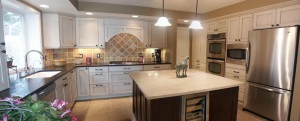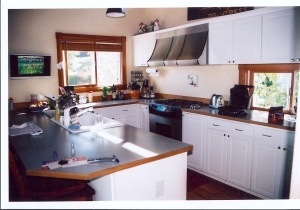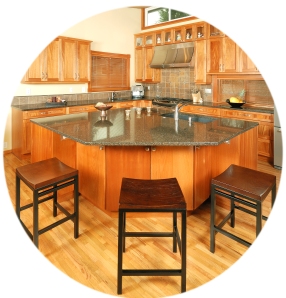If my memory serves me well, it happened the 1992 Summer Olympic in Barcelona, Spain. A runner in one of the mid-length races fell, injured his leg, got up, and continued to run as best he could. Long after everyone else had crossed the finish line, this runner rounded the last bend, looking like he could go no further. His father left the stands, ran to his side and all but carried him across the finish line. Asked why he kept running, he said, “My country didn’t send me here to run the race, but to finish it.” I know it’s a stretch, but what he said in that the finish is important. The same is true in cabinetry!
Last week we looked at, “What Makes a Custom Cabinet Custom,” noting that the distinction between custom and factory built cabinets has diminished over the years. But there is one facet of manufacturing process that should be considered in deciding who will build your cabinets: The Finish.
For years, lacquer was considered the best finish for natural or stained cabinets. For painted cabinets: paint. (You wouldn’t want to put lacquer over the paint because, over time, lacquer yellows – changing the paint color.) During the 1970’s, a product was developed called a “Catalyzed Conversion Varnish.” Without getting to technical, this varnish is a two part system (varnish and catalyst) When the catalyst is introduced to the varnish, a chemical reaction begins. This reaction is what makes the varnish harden to a tough, durable, clear finish. The temperature must remain above 70 degrees ferinheight for 24 hours to cure. Coatings cured at lower temperatures are prone to cracking, checking and brittleness. Higher temperatures will shorten curing time and increase the durability of the finish. But, don’t just turn up the thermostat. The temperature must be consistent, and different wood species respond best at different temperatures. Also, the thickness of multiple coats should not total more than 4.0 mils – that’s 4/1000 of an inch!
To guarantee meeting these demanding specs, many of the better manufacturers use a system made by “Cefla.” In this system, the finish is applied to horizontal surfaces (no run, no drips…)on conveyer belts by computer driven robotics. The computer knows where to spray and where not to spray (between pieces), saving 30% of the varnish – that’s before recycling the overspray. This Cefla equipment cost well over $500,000. This makes two points obvious: 1] Manufacturers who use it view it as an efficient tool that makes their product significantly better. 2] Small, old world craftsman can’t afford to own a Cefla because their volume would not warrant it. (Catalyzed Conversion Varnish can be applied without the expensive equipment, but not with the same consistent results.)
Catalyzed Conversion Varnish has many advantages over lacquer: Sherwin Williams, the primary supplier of cat. Conv. Varnish to cabinet manufacturers has done extensive testing of their product:
“Household Chemicals Test”
“Panels were aged 30 days at 77°F, 5 drops of each item were placed under a watch glass for one hour. Film was rinsed with water, washed with warm water and soap, dried, and wiped with VM&P Naphtha to remove items not removed with water.
Mustard……………………….…no visual effect
Oil Base Paint………………..…no visual effect
Latex Emulsion Paint……….no visual effect
VM&P Naphtha……….………no visual effect
Turpentine………………………no visual effect
Orange Crayon…………………no visual effect
Carbon Tetrachloride……….no visual effect
Mayonnaise……………………..no visual effect
10% Sodium Carbonate ……no visual effect
Sour Milk…………………………no visual effect
Margarine……………………….no visual effect
Butter……………………………..no visual effect
Water……………………………..no visual effect
Cooking Fat…………………….no visual effect”
We also tried Acetone, a form of paint thinner. No visual effect. This is significant because acetone occurs naturally in our sweat glands. This is why lacquer finishes get gummy after several years. The point is: Catalyzed Conversion Varnish is far superior to lacquer or conventional varnishes in clarity and durability. Cat. Conv. Varnish is so clear; it can be (and is) used as a sealer over painted cabinets.
So, in answer to the heart of last week’s question: Having found a good designer that will help you think through every aspect of their kitchen focusing on your taste, lifestyle and budget, the finish used becomes significant. With very few exceptions, the better manufacturers produce a far superior product to the “custom cabinets” built in a small shop. Once again, in the 21st century, it’s the designer that makes the cabinets “custom”.
See you next time,
Ross

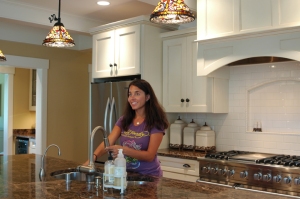
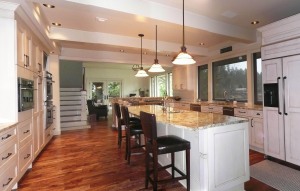
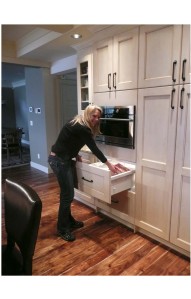
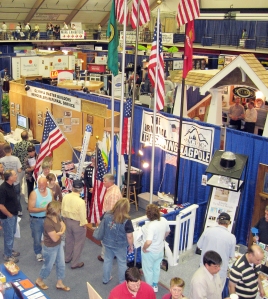 Do you need ideas for a future home improvement project?… Are you planning to build a new home?
Do you need ideas for a future home improvement project?… Are you planning to build a new home?



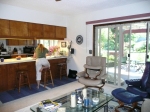 Back in the “good old days,” the cook often felt left out of the conversation with family and guests — but at least the mess was hidden. In the 80’s, builders began putting in a “pass-through” from the kitchen to the living area. Then the cook could participate in the revelry — sort of….
Back in the “good old days,” the cook often felt left out of the conversation with family and guests — but at least the mess was hidden. In the 80’s, builders began putting in a “pass-through” from the kitchen to the living area. Then the cook could participate in the revelry — sort of….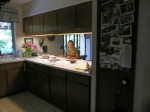 If the cook was a good conversationalist, people would gravitate to the pass-through, often bending over or sitting on stools to see beneath the upper cabinets. If the pass-through was full, or there were no stools to ease the guest’s back pain, they began to gravitate into the kitchen — sometimes getting in the way! The cooks were often embarrassed by the mess, but glad to be a part of the festivities. The food would be served — eventually, but the quality may have suffered in the process.
If the cook was a good conversationalist, people would gravitate to the pass-through, often bending over or sitting on stools to see beneath the upper cabinets. If the pass-through was full, or there were no stools to ease the guest’s back pain, they began to gravitate into the kitchen — sometimes getting in the way! The cooks were often embarrassed by the mess, but glad to be a part of the festivities. The food would be served — eventually, but the quality may have suffered in the process.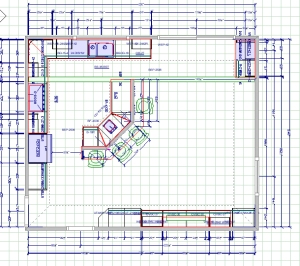


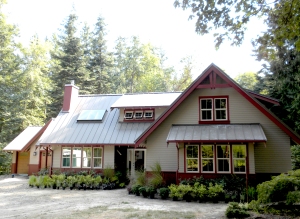
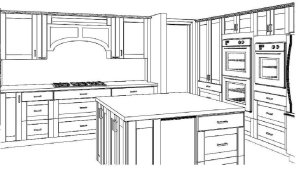



 s, and did not want us to come out to look at their space. We ordered exactly what they requested, but we could not have read their minds to know that there were arched headers on each side of the fireplace, resulting in doors that would not fully open.
s, and did not want us to come out to look at their space. We ordered exactly what they requested, but we could not have read their minds to know that there were arched headers on each side of the fireplace, resulting in doors that would not fully open.

